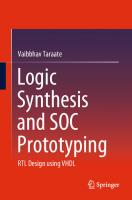Logic Synthesis with VHDL Combinational Logic
Reese B. Logic Synthesis with VHDL Combinational Logic. Учебное пособие на английском языке. Mississippi State Universit
409 42 280KB
English Pages [46]
Recommend Papers

- Author / Uploaded
- Reese B.
- Similar Topics
- Computers
- Programming: Modeling languages
- Commentary
- 1424273
File loading please wait...
Citation preview
Electrical & Computer Engineering
Mississippi State University
Logic Synthesis ⇒ Use of Logic Synthesis has become common industrial practice.
The advantages are many: → Technology portability → Design Documentation
Logic Synthesis with VHDL Combinational Logic
→ Constraint Driven Synthesis ⇒ Two major languages are Verilog and VHDL. This tutorial will con-
ver logic synthesis via VHDL. ⇒ We will split the tutorials into three parts: → Introduction to VHDL via combinational synthesis examples → Sequential synthesis examples (registers, finite state
machines)
Bob Reese Electrical Engineering Department Mississippi State University
→ System examples (combined datapath and control)
Bob Reese 5/95
CombSyn–2
Combinational Synthesis with VHDL
Electrical & Computer Engineering
Mississippi State University
Electrical & Computer Engineering
VHDL Synthesis Subset
Tutorial Caveats ⇒ Tutorial examples have been made as simple and portable as pos-
sible.
Mississippi State University
⇒ The VHDL language has a reputation for being very complex - that
reputation is well deserved! ⇒ Fortunately, the subset of VHDL which can be used for synthesis is
→ Will stay away from topics such as parameterization which
may involve vendor–dependent features. → Will also stay away from coding styles which involve type
conversion as this tends to add extra complications. ⇒ Examples have been tested with the Synopsys and Viewlogic syn-
thesis tools; most of the synthesized schematics shown in the slides are from the Viewlogic synthesis tool. Some of the more complex examples are only compatible with the Synopsys environment
SMALL - very easy to learn. ⇒ Primary VHDL constructs we will use for synthesis: → signal assignment
nextstate (greater than), < (less than) = (greater than or equal) → logical operators
⇒ In these tutorials, the suggested styles for writing synthesizable
VHDL models come from my own experience in teaching an ASIC design course for Senior/Graduate EE students.
(and, xor, or, nand, nor, xnor, not ) → ’if’ statement
if ( presentstate = CHECK_CAR ) then .... end if | elsif ....
⇒ Coverage of VHDL packages will be light; the block structural
statements and VHDL configurations are skipped. Generics are not mentioned until late in the tutorial since support from a synthesis point of view is vendor dependent. ⇒ This tutorial is no substitute for a good, detailed VHDL textbook or
→ ’for’ statement (used for looping in creating arrays of
elements) → Other constructs are ’when else’, ’case’ , ’wait ’. Also ”:=” for
variable assignment.
the language reference manual. Get one or both!!! Bob Reese 5/95
CombSyn–3
Combinational Synthesis with VHDL
Bob Reese 5/95
CombSyn–4
Combinational Synthesis with VHDL
Electrical & Computer Engineering
Mississippi State University
Electrical & Computer Engineering
Mississippi State University
General Comments on VHDL Syntax
Combinational Logic Examples
⇒ Most syntax details will be introduced on an ’as–needed’ basis.
⇒ We will go through some combinational examples to introduce you
→ The full syntax of a statement type including all of its various
to the synthesizable subset of VHDL. Usually, we will demonstrate multiple methods of implementing the same design.
options will often NOT be presented; instead, these will be introduced via examples as the tutorial progresses.
⇒ Examples are:
→ There are many language details which will be glossed over or
→ 2 to 1 Mux
simply skipped for the sake of brevity. ⇒ Generalities:
→ 8-level priority circuit → 3 to 8 Decoder
→ VHDL is not case sensitive.
→ Synthesis boundary conditions
→ The semicolon is used to indicate termination of a statement.
→ Ripple–carry adder
→ Two dashes (’––’) are used to indicate the start of a comment. → Identifiers must begin with a letter, subsequent characters
must be alphanumeric or ’_’ (underscore). → VHDL is a strongly typed language.
There is very little automatic type conversion; most operations have to operate on common types. Operator overloading is supported in which a function or procedure can be defined differently for different argument lists.
Bob Reese 5/95
CombSyn–5
Combinational Synthesis with VHDL
Bob Reese 5/95
CombSyn–6
Combinational Synthesis with VHDL
Electrical & Computer Engineering
Mississippi State University
Model Template
Electrical & Computer Engineering
Mississippi State University
2–to–1 MUX –– Using when else
entity model_name is library IEEE; use IEEE.std_logic_1164.all;
port ( list of inputs and outputs
–– vhdl model for 2 to 1 mux, 8–bits wide entity mux2to1 is port ( signal s: in std_logic; signal zero,one: in std_logic_vector(7 downto 0); signal y: out std_logic_vector(7 downto 0) ); end mux2to1;
); end model_name;
architecture architecture_name of model_name is begin ... VHDL concurrent statements ....
architecture behavior of mux2to1 is begin
end architecture_name ;
mux2to1
y
![Introduction to Logic Circuits & Logic Design with VHDL [3 ed.]
3031425464, 9783031425462](https://ebin.pub/img/200x200/introduction-to-logic-circuits-amp-logic-design-with-vhdl-3nbsped-3031425464-9783031425462.jpg)




![Fundamentals of Digital Logic with VHDL Design [4 ed.]
9781260597783, 1260597784](https://ebin.pub/img/200x200/fundamentals-of-digital-logic-with-vhdl-design-4nbsped-9781260597783-1260597784.jpg)

![Digital Logic and Microprocessor Design with VHDL [1 ed.]
9780534465933, 0534465935](https://ebin.pub/img/200x200/digital-logic-and-microprocessor-design-with-vhdl-1nbsped-9780534465933-0534465935.jpg)

